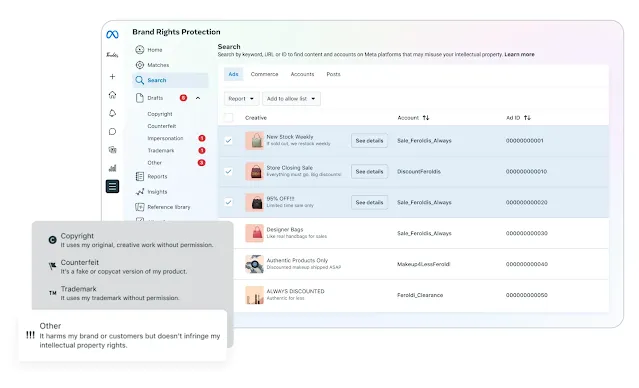The update means companies and brands can now flag suspicious campaigns even when the ads do not directly lift their logos or imagery. That covers cases where a brand’s name is used without permission or where false claims are tied to the brand in an attempt to mislead. The move follows a string of incidents in which prominent journalists, broadcasters, and entrepreneurs were impersonated in online investment schemes.
First launched in October 2021 and once known as the Commerce & Ads IP Tool, Brand Rights Protection lets registered trademark owners monitor and report misuse of their brands on Facebook and Instagram. It scans ads, posts, pages, and accounts for potential infringements, using image-matching technology to spot content that resembles uploaded reference files. Businesses can store up to 10 such images (logos, product shots, or other brand markers) to help the system flag suspicious material.
Meta has also reworked the tool’s navigation. The Drafts tab, previously called Requests, now splits reports into categories for copyright, counterfeit, impersonation, and trademark violations. In the Reports tab, users can filter results by keywords, trademark names, report owner details, or unique email report IDs. Those targeting scam ads specifically are advised to choose the “Other” violation type in the Ads section.
The system’s reach currently covers Facebook and Instagram, though scam activity has also been spotted on WhatsApp, where the same enforcement measures are not in place. Publishers and brand owners say that removing harmful ads can feel like an endless cycle, with new ones appearing soon after the old ones are removed.
Meta says its automated review and detection systems remove millions of fraudulent posts and accounts. In 2024 alone, the company took down more than 157 million pieces of advertising content worldwide for breaking its rules on fraud, scams, and deceptive business practices. The company believes that the expanded Brand Rights Protection features will give businesses more control over their identities online and help reduce the spread of misleading material.

Notes: This post was edited/created using GenAI tools.
Read next: Anthropic Expands Claude With On Demand Memory Retrieval for Subscribers
